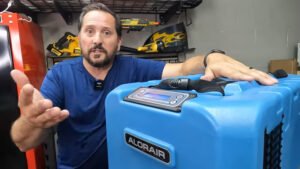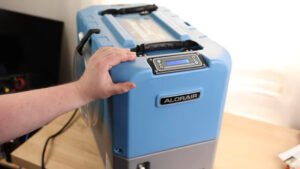Effective moisture control in industrial settings requires a clear understanding of both acquisition and running expenses. Industrial moisture control solutions span equipment designed for warehouse dehumidifier solutions, large-scale dehumidifiers for factories and desiccant-based humidity management systems. Purchasing high-capacity dehumidifiers involves substantial capital outlay. Operationally, energy consumption and upkeep can account for a significant portion of lifecycle expenses. Precise budgeting enables facility managers and financial planners to forecast expenditures, compare model efficiencies and select professional dehumidification systems that align with institutional and regulatory requirements.
Initial Investment: Purchase Costs

Capital expenditure for commercial dehumidification systems varies according to capacity, technology and application. Portable units offering 150–250 pints per day typically range from USD $500 to $1 000. For instance, a 155-pint commercial dehumidifier is listed at USD $529.99 on specialized retail sites (Kesnos). Mid-range options around 300 pints per day command approximately USD $800–900 (Kesnos). High-capacity refrigerant dehumidifiers designed for warehouse or basement applications (up to 700 pints per day) average USD $2 400 (Amazon). Custom industrial systems, including desiccant rotor platforms for data centers or process control, start near USD $3 000 and may exceed USD $60 000 as reported in surplus markets for large-scale units (bid-on-equipment.com). Specialized climate control deployments in controlled-atmosphere cold storage or pharmaceutical manufacturing often require integrated humidity management systems with HVAC interfacing, pushing purchase costs beyond USD $100 000.
Energy Expenditure and Efficiency Metrics
Running expenses predominantly derive from electric power consumption. Refrigerant-cycle dehumidifiers typically draw 500–3 500 watts per hour, contingent on scale and technology. Small to medium industrial machines (500 W to 1 500 W) incur moderate operating costs, while large-scale dehumidifiers (1 500 W to 3 500 W) can consume upwards of 28 kWh over an eight-hour shift (Preair). Energy Star data indicate whole-home dehumidifiers with removal rates of 127.5 pints/day average 842 kWh annually; larger units (172 pints/day) draw up to 1 188 kWh per year (ENERGY STAR). An expert evaluated continuous operation at 13–21 kWh per day, equating to USD 2.00–3.40 daily at USD 0.16/kWh: “Running continuously, these dehumidifiers can consume up to 13-21 kWh per day. Assuming your energy is around $0.16/kWh, they amount to roughly $2.00-$3.40 per day” (Better Homes & Gardens). At industrial rates (€0.10/kWh), a 1.5 kW unit operating 2 000 hours annually yields €300, whereas a 3.5 kW system could incur €700 per annum.
Maintenance and Ancillary Expenses
Maintenance represents routine capital at 5–10 percent of equipment cost annually. Filter replacements average USD 100–200 per unit per year; compressors and fans may require replacement on a 5- to 10-year cycle at costs ranging from USD 500 to USD 2 000 per major component. Desiccant dehumidifiers demand periodic rotor checks and potential media replacement, with parts and labor ranging USD 1 000–5 000 every 5–7 years (munters.com). Service contracts for professional dehumidification include preventive inspections, calibration of humidistats and refrigerant charge verification; annual fees range USD 500–1 500 depending on unit count and facility complexity. Additional system-level maintenance for integrated commercial climate control may involve duct cleaning, motor servicing and control system firmware updates, typically adding another 2–4 percent of initial CAPEX annually.
Lifecycle Cost Analysis
Total cost of ownership (TCO) comprises purchase cost, energy use and maintenance over the equipment’s design life (typically 10–15 years). For a mid-range 250 pint/day unit at USD 800:
- Acquisition: USD 800
- Energy: 0.7 kW × 2 500 hours/year × $0.12/kWh × 10 years = USD 2 100
- Maintenance: $150 filter × 10 years + $800 replaced compressor at Year 7 + service ($600 × 10 years) = USD 1500 + 800 + 6000 = USD 8 300
TCO ˜ USD 11 200 over ten years.
Contrast with a large-scale 700 pint/day model at USD 2 400:
- Acquisition: USD 2 400
- Energy: 2.5 kW × 3 000 hours/year × $0.12/kWh × 10 years = USD 9 000
- Maintenance: $200 filter × 10 + $1 500 rotor service at Year 5 + service ($1 000 × 10) = USD 2 000 + 1 500 + 10 000 = USD 13 500
TCO ˜ USD 24 900 over ten years.
These figures illustrate that larger equipment tends to have higher absolute TCO yet may offer lower cost per pint of moisture removed when operated at scale.
Scenario Analysis: Warehouse vs Factory Deployment
A 100 000 ft² warehouse applying warehouse dehumidifier solutions at 60 percent RH may require 4 units of 305 pint/day capacity (total 1 220 pints/day). At USD 799 each, CAPEX is USD 3 196. Annual energy at 0.8 kW × 8 000 hours × €0.10/kWh = €640 per unit; €2 560 total. Annual maintenance €200 per unit, €800 total. Over ten years, TCO approximates USD 3 196 + (€3 360 + €8 000) ˜ €14 556. Cost per pint removed ˜ €0.011.
Contrast a factory installing a humidity management system with 5 ton desiccant rotor units (705 pints/day) at USD 11 750 each; two units cost USD 23 500 CAPEX. Energy consumption of 3 kW × 8 000 hours × €0.10/kWh = €2 400 per unit; €4 800. Maintenance €1 000 annual per unit; €10 000 over ten years. TCO ˜ USD 23 500 + (€9 600 + €20 000) ˜ €53 100. Cost per pint removed ˜ €0.019.
This comparison shows scale and technology choices (refrigerant vs desiccant) significantly influence both TCO and unit removal cost.
Dehumidifier Buying Tips
- Match Capacity to Load: Oversizing yields energy penalty through frequent cycling; undersizing fails to maintain RH setpoints.
- Assess Integrated Energy Factors: Seek models with higher L/kWh from Energy Star listings (ENERGY STAR).
- Consider Desiccant for Low-Temperature: Rotary desiccant units excel below 15 °C but incur higher CAPEX and maintenance (airtreatment.co.za).
- Factor Installation Complexity: Hard-wired units with ducting increase initial plant costs by 10–20 percent compared with plug-and-play portable units.
- Review Warranty and Service: Five-year warranties on compressors and rotors reduce mid-life replacement risks (boltontool.com).
- Plan for Drainage: Pumped condensate removal may add USD 200–500 for lift pumps; gravity-drain installations require floor slopes and piping.
- Evaluate Noise and Footprint: Industrial dehumidifiers may exceed 70 dB(A); consider acoustic enclosures in noise-sensitive areas.
Financial Considerations and Return on Investment
Cost savings arise from reduced product spoilage, decreased corrosion, improved indoor air quality and extended equipment lifespan. For food storage, preventing mold and clumping can avert losses exceeding USD 50 000 annually in a 10 000 m³ silo. Simple payback is calculated by dividing incremental TCO by annual savings. A pharmaceutical clean-room saving USD 20 000 per year in rejected batches achieves payback on a USD 60 000 system in three years. Tax incentives and energy rebates further improve returns. Key metrics include Internal Rate of Return (IRR) — often 12–18 percent for energy-efficient installations — and Net Present Value (NPV), which factors in discount rates and projected utility inflation.
Effective budgeting for professional dehumidification demands rigorous cost-benefit analysis. By quantifying both buying and operating costs, facility planners can deploy commercial moisture removal technologies that balance financial discipline with compliance to environmental and quality standards.



